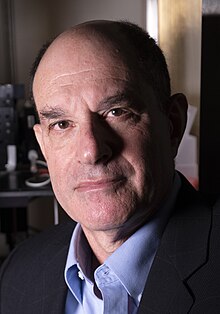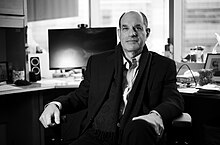David Julius
David Julius | |
|---|---|
 Julius in 2022 | |
| Born | November 4, 1955 New York City, U.S. |
| Education | Massachusetts Institute of Technology(BS) University of California, Berkeley(MS,PhD) Columbia University(post-doctoral training) |
| Spouse | Holly Ingraham |
| Awards | |
| Scientific career | |
| Fields | Physiology Biochemistry Neuroscience |
| Institutions | University of California, San Francisco |
| Thesis | Protein processing and secretion in yeast: biosynthesis of α-factor mating pheromone(1984) |
| Doctoral advisor | Jeremy Thorner Randy Schekman |
| Other academic advisors | Richard Axel[1] Alexander Rich |
David Jay Julius(born November 4, 1955) is an AmericanphysiologistandNobel Prizelaureate known for his work onmolecular mechanismsofpainsensation and heat, including the characterization of theTRPV1andTRPM8receptors that detectcapsaicin,menthol,and temperature. He is a professor at theUniversity of California, San Francisco.
Julius won the 2010Shaw PrizeinLife ScienceandMedicineand the 2020Breakthrough Prize in Life Sciences.[2][3]In 2020 he was awardedThe Kavli Prize,[4]and in 2021 theNobel Prize in Physiology or Medicinejointly withArdem Patapoutian.[5]
Early life and education[edit]
Julius was born to anAshkenazi Jewishfamily (from Russia) inBrighton Beach,Brooklyn,New York City,[6]where he attendedAbraham Lincoln High School.[7]He earned his undergraduate degree fromMassachusetts Institute of Technologyin 1977. He attained his doctorate fromUniversity of California, Berkeleyin 1984, under joint supervision ofJeremy ThornerandRandy Schekman,where he identifiedKex2as the founding member offurin-likeproprotein convertases.[8]In 1989, he completed hispost-doctoral trainingwithRichard AxelatColumbia Universitywhere he cloned and characterized the serotonin 1c receptor.[9]
While at Berkeley and Columbia, Julius became interested in howpsilocybin mushroomsandlysergic acid diethylamidework, which led him to look more broadly into how things from nature interact with human receptors.[7]
Research career[edit]

He started his career as faculty at theUniversity of California, San Franciscoin 1989.[10][11]In 1997, Julius's lab cloned and characterizedTRPV1which is the receptor that detectscapsaicin,the chemical inchili peppersthat makes them "hot".[12]They found thatTRPV1also detects noxious heat (thermoception).[12][13]TRPV1 is part of a large family of structurally relatedTRP (transient receptor potential)cation channels. Animals that lack TRPV1 (using genetic knockouts of the protein) lose sensitivity to noxious heat and capsaicin.[14]
Julius's lab has also cloned and characterizedTRPM8(CMR1) andTRPA1,both members of theTRPsuperfamily. They demonstrated that TRPM8 detectsmentholand cooler temperatures[15][16]andTRPA1detectsmustard oil(allyl isothiocyanate).[17]These observations suggested that TRP channels detect a range of temperatures and chemicals. David Julius's lab has also made contributions to the study ofnociceptionby discovering toxins that modulate these channels,[18]describing unique adaptations of the channels in diverse species[19]and solving thecryo-EMstructures of numerous channels.[20][21]

From 2007–2020 Julius served as the editor of the peer-reviewed journal theAnnual Review of Physiology.[22][23]
Awards[edit]
In 2000, Julius was awarded the inauguralPerl-UNC Neuroscience Prizefor his work on cloning thecapsaicin receptor.In 2010, he won theShaw Prizefor his work identifying theion channelsinvolved in various aspects ofnociception.In 2014, he was honored byJohnson & Johnsonwith theDr. Paul Janssen Award for Biomedical Researchfor discovering the molecular basis for pain and thermosensation. In 2017, he won theGairdner Foundation International Award[24]and theHFSP Nakasone Award.[25]He has also been awarded the 2010Prince of Asturias PrizeforTechnical and Scientific Research,the 2020Breakthrough Prize in Life Sciences,[26]and the 2020Kavli Prizein Neuroscience (together withArdem Patapoutian)[4]and the 2020BBVA Foundation Frontiers of Knowledge Award.[27]
In 2021, he was awarded theNobel Prizein Physiology or Medicine jointly withArdem Patapoutianfor their discoveries of receptors for temperature and touch.[28]
See also[edit]
References[edit]
- ^"Julius Lab at UCSF Mission Bay | David Julius Lab".Archivedfrom the original on May 23, 2013.RetrievedNovember 30,2013.
- ^"Julius Named to Receive the Shaw Prize".ucsf.edu.Archivedfrom the original on April 29, 2019.RetrievedDecember 5,2016.
- ^"David Julius, PhD 49th Faculty Research Lecture Award".senate.ucsf.edu.Archivedfrom the original on August 1, 2020.RetrievedDecember 5,2016.
- ^ab"2020 Kavli Prize in Neuroscience".kavliprize.org.Archived fromthe originalon June 15, 2020.RetrievedMay 27,2020.
- ^"The Nobel Prize in Physiology or Medicine 2021".NobelPrize.org.Archivedfrom the original on October 4, 2021.RetrievedOctober 4,2021.
- ^Hanau, Shira (October 4, 2021)."Scientist David Julius, whose grandparents fled antisemitism in Czarist Russia, wins Nobel Prize in medicine".Jewish Telegraphic Agency.RetrievedOctober 4,2021.
- ^abMueller, Benjamin; Santora, Marc; Engelbrecht, Cora (October 4, 2021)."Nobel Prize Awarded for Research About Temperature and Touch".New York Times.RetrievedOctober 5,2021.
- ^Julius, David Jay (1984).Protein Processing and Secretion in Yeast: Biosynthesis of Alpha-Factor Mating Pheromone(Ph.D. thesis).University of California, Berkeley.OCLC21756165.ProQuest303332941.
- ^Julius, D.; MacDermott, A. B.; Axel, R.; Jessell, T. M. (July 29, 1988). "Molecular characterization of a functional cDNA encoding the serotonin 1c receptor".Science.241(4865): 558–564.Bibcode:1988Sci...241..558J.doi:10.1126/science.3399891.ISSN0036-8075.PMID3399891.
- ^"David Julius '77 shares the Nobel Prize in physiology or medicine".MIT News | Massachusetts Institute of Technology.RetrievedOctober 7,2021.
- ^"The Nobel Prize in Physiology or Medicine 2021".NobelPrize.org.RetrievedOctober 7,2021.
- ^abCaterina, M. J.; Schumacher, M. A.; Tominaga, M.; Rosen, T. A.; Levine, J. D.; Julius, D. (October 23, 1997)."The capsaicin receptor: a heat-activated ion channel in the pain pathway".Nature.389(6653): 816–824.Bibcode:1997Natur.389..816C.doi:10.1038/39807.ISSN0028-0836.PMID9349813.S2CID7970319.
- ^Tominaga, M.; Caterina, M. J.; Malmberg, A. B.; Rosen, T. A.; Gilbert, H.; Skinner, K.; Raumann, B. E.; Basbaum, A. I.; Julius, D. (September 1998)."The cloned capsaicin receptor integrates multiple pain-producing stimuli".Neuron.21(3): 531–543.doi:10.1016/S0896-6273(00)80564-4.ISSN0896-6273.PMID9768840.S2CID2054891.
- ^Caterina, M. J.; Leffler, A.; Malmberg, A. B.; Martin, W. J.; Trafton, J.; Petersen-Zeitz, K. R.; Koltzenburg, M.; Basbaum, A. I.; Julius, D. (April 14, 2000). "Impaired nociception and pain sensation in mice lacking the capsaicin receptor".Science.288(5464): 306–313.Bibcode:2000Sci...288..306C.doi:10.1126/science.288.5464.306.ISSN0036-8075.PMID10764638.
- ^McKemy, David D.; Neuhausser, Werner M.; Julius, David (March 7, 2002). "Identification of a cold receptor reveals a general role for TRP channels in thermosensation".Nature.416(6876): 52–58.Bibcode:2002Natur.416...52M.doi:10.1038/nature719.ISSN0028-0836.PMID11882888.S2CID4340358.
- ^Bautista, Diana M.; Siemens, Jan; Glazer, Joshua M.; Tsuruda, Pamela R.; Basbaum, Allan I.; Stucky, Cheryl L.; Jordt, Sven-Eric; Julius, David (July 12, 2007). "The menthol receptor TRPM8 is the principal detector of environmental cold".Nature.448(7150): 204–208.Bibcode:2007Natur.448..204B.doi:10.1038/nature05910.ISSN1476-4687.PMID17538622.S2CID4427901.
- ^Jordt, Sven-Eric; Bautista, Diana M.; Chuang, Huai-Hu; McKemy, David D.; Zygmunt, Peter M.; Högestätt, Edward D.; Meng, Ian D.; Julius, David (January 15, 2004). "Mustard oils and cannabinoids excite sensory nerve fibres through the TRP channel ANKTM1".Nature.427(6971): 260–265.Bibcode:2004Natur.427..260J.doi:10.1038/nature02282.ISSN1476-4687.PMID14712238.S2CID4354737.
- ^Bohlen, Christopher J.; Chesler, Alexander T.; Sharif-Naeini, Reza; Medzihradszky, Katalin F.; Zhou, Sharleen; King, David; Sánchez, Elda E.; Burlingame, Alma L.; Basbaum, Allan I. (November 16, 2011)."A heteromeric Texas coral snake toxin targets acid-sensing ion channels to produce pain".Nature.479(7373): 410–414.Bibcode:2011Natur.479..410B.doi:10.1038/nature10607.ISSN1476-4687.PMC3226747.PMID22094702.
- ^Gracheva, Elena O.; Ingolia, Nicholas T.; Kelly, Yvonne M.; Cordero-Morales, Julio F.; Hollopeter, Gunther; Chesler, Alexander T.; Sánchez, Elda E.; Perez, John C.; Weissman, Jonathan S. (April 15, 2010)."Molecular basis of infrared detection by snakes".Nature.464(7291): 1006–1011.Bibcode:2010Natur.464.1006G.doi:10.1038/nature08943.ISSN1476-4687.PMC2855400.PMID20228791.
- ^Liao, Maofu; Cao, Erhu; Julius, David; Cheng, Yifan (December 5, 2013)."Structure of the TRPV1 ion channel determined by electron cryo-microscopy".Nature.504(7478): 107–112.Bibcode:2013Natur.504..107L.doi:10.1038/nature12822.ISSN1476-4687.PMC4078027.PMID24305160.
- ^Cao, Erhu; Liao, Maofu; Cheng, Yifan; Julius, David (December 5, 2013)."TRPV1 structures in distinct conformations reveal activation mechanisms".Nature.504(7478): 113–118.Bibcode:2013Natur.504..113C.doi:10.1038/nature12823.ISSN1476-4687.PMC4023639.PMID24305161.
- ^Julius, David (2007). "David Julius for the ARP Editorial Committee".Annual Review of Physiology.69.doi:10.1146/annurev.ph.69.013107.100001.
- ^"Editor of the Annual Review of Physiology - Volume 82, 2020".Annual Reviews.RetrievedJuly 26,2021.
- ^"David Julius – Gairdner Foundation".Gairdner Foundation.Archivedfrom the original on October 22, 2020.RetrievedNovember 1,2018.
- ^"The 2017 HFSP Nakasone Award goes to David Julius | Human Frontier Science Program".hfsp.org.Archived fromthe originalon November 9, 2018.RetrievedNovember 9,2018.
- ^"Breakthrough Prize – Winners Of The 2020 Breakthrough Prize In Life Sciences, Fundamental Physics And Mathematics Announced".breakthroughprize.org.Archivedfrom the original on December 14, 2019.RetrievedOctober 4,2021.
- ^"homepage".Premios Fronteras.Archivedfrom the original on September 21, 2021.RetrievedOctober 4,2021.
- ^"The Nobel Prize in Physiology or Medicine 2021".NobelPrize.org.Archivedfrom the original on October 4, 2021.RetrievedOctober 4,2021.
External links[edit]
- 1955 births
- Abraham Lincoln High School (Brooklyn) alumni
- American people of Russian-Jewish descent
- American physiologists
- Annual Reviews (publisher) editors
- Jewish American scientists
- Kavli Prize laureates in Neuroscience
- Living people
- Massachusetts Institute of Technology alumni
- Members of the United States National Academy of Sciences
- Nobel laureates in Physiology or Medicine
- Scientists from New York City
- University of California, Berkeley alumni
- Columbia University staff
- University of California, San Francisco faculty
- Members of the National Academy of Medicine
